The NVIDIA GeForce GTX 1650 Super Review, Feat. Zotac Gaming: Bringing Balance To 1080p
by Ryan Smith on December 20, 2019 9:00 AM ESTSynthetics
Moving on to synthetic performance testing, there shouldn’t be any surprises here. This is the 4th TU116 card we’ve looked at – albeit the first with just a 128-bit memory bus – so its behavior is generally well understood.
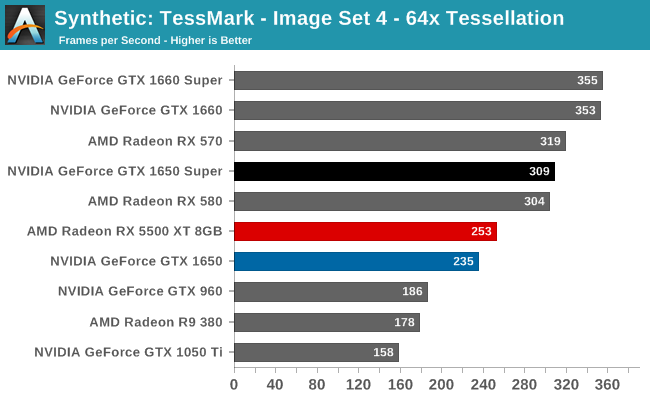
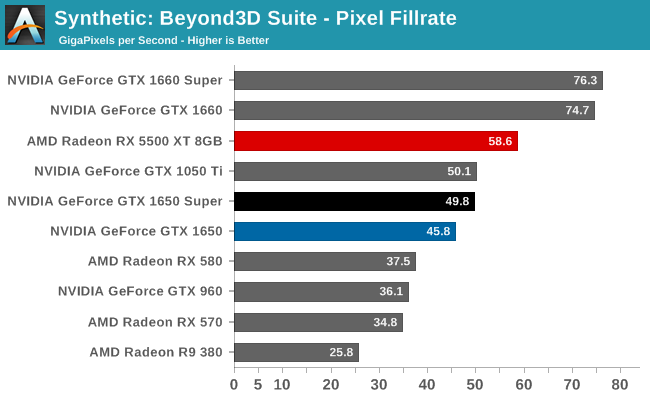
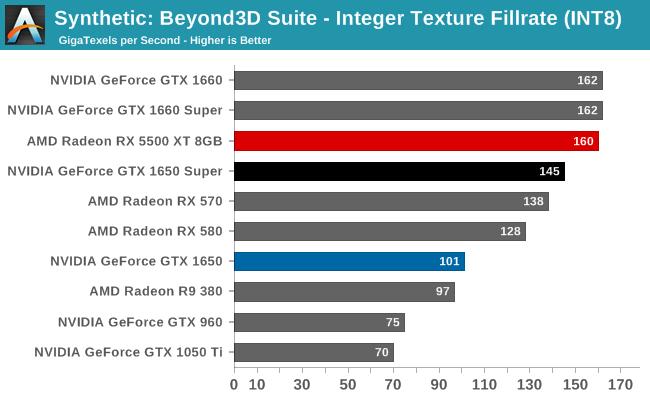

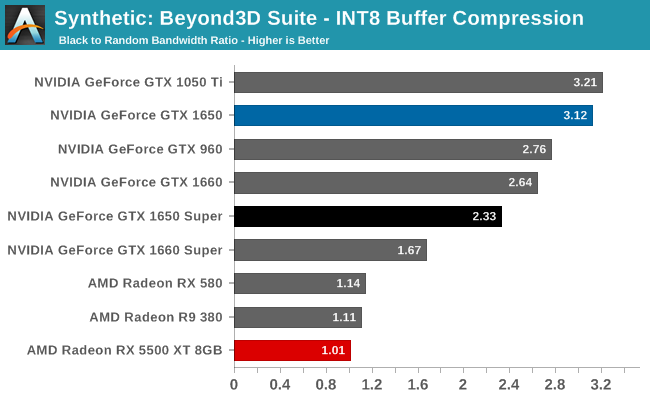
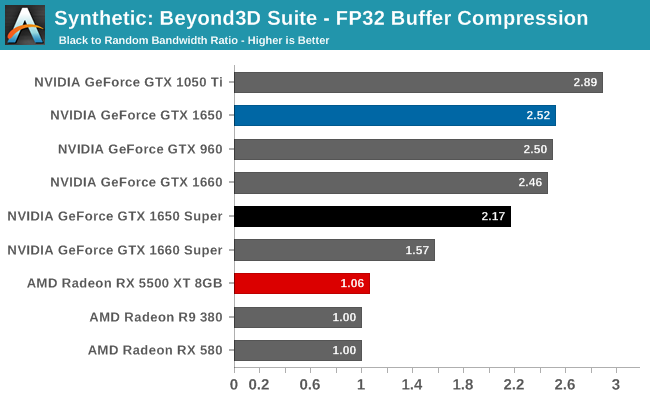
With synthetic performance, we see the GTX 1650 Super benefitting significantly with tessellation throughput, most likely due to the inclusion of more GPCs to house the greater SM count. This still leaves it behind the GTX 1660 cards, but relatively close overall. Meanwhile we see just a slight uptick in pixel throughput, reflecting the fact that while the card has a good deal more memory bandwidth than the regular GTX 1650, for this simple (and generally well compressible) test, it doesn’t add much.










67 Comments
View All Comments
Marlin1975 - Friday, December 20, 2019 - link
Little disappointing. Lower performance than a 580 and higher priced than others in its price range.If the price was quiet a bit lower then it might make a decent HTPC card for some.
HarryVoyager - Friday, December 20, 2019 - link
The 8Gb 580's, both new and used, are going to be the elephant in the room for a while I suspect. A reasonably cared for miner card runs only $100 and will keep you going at least until AMD is competitive enough to drive nVidia's pricing down.Yojimbo - Friday, December 20, 2019 - link
A reasonably cared for mining card...? How do you assure that?The 580s have been so cheap because AMD made too many of them. Nvidia are not so interested in low end market share. They'll sell cards there if they can make money on them. I have a feeling GDDR6 dram has come down in price in the last year more than 7 nm fabrication cost has. Now they can sell in that market segment with good profits.
Retycint - Friday, December 20, 2019 - link
I would imagine most miners run their cards undervolted/underclocked for maximum efficiency. And it's a 24/7 load, unlike the periodic low->high->low load of gaming cards, which is actually better for the card in the long run. So miner cards actually tend to be in better condition (save for the fans, of course).But then again, there's the risk of miner cards that have had modded BIOSes installed which might have damaged the card? So I suppose it's down to buying from a reputable seller
Yojimbo - Friday, December 20, 2019 - link
They would have undervolted and then pushed it to get the most performance they could without crashes and run it 24/7. It would be sitting in a hot case in a hot room. I don't think it's a particularly desirable card. But my question is actually in response to what your conclusion was: How do we judge a mining card? What do you mean a reputable seller? A 3rd party that picked up the card fro some miner?PeachNCream - Saturday, December 21, 2019 - link
GPU mining was typically done with open air brackets rather than in a densely packed case. However, GPU mining is a lot less commonplace these days given the low profitability. We are past that being a thing really so finding a modern ex-miner GPU is not as easy of a prospect as it was even a couple of years ago.Kangal - Saturday, December 21, 2019 - link
The thing is Mining Cards really are Gaming Cards.There's less than 1% performance and thermal difference between the two. Even Linus TechTips did an experiment on this by comparing a mining card that was used for 4 years constantly, compared to the exact same card (same variant) which was still sealed in the box. No difference.
At worst case scenario, the used card is not going to have warranty, and you may need to "refurbish" it yourself: clean the case, clean the innards, reapply thermal paste, put in new fans. All up it's going to cost you $5-$20. So when you're saving yourself $50-$100 it's worth it, from a value point.
MamiyaOtaru - Sunday, December 22, 2019 - link
nobody thinks there is a performance difference between an ex mining card and a new card. Performance doesn't do a slow fade. The worry is that the mining card could be that much closer to failure.Kangal - Sunday, December 22, 2019 - link
Actually, heaps of people think mining cards run hotter, use more power, and run slower compared to Brand New. It's actually a very widespread misconception.Mining cards being closer to failure is actually a myth as well. If the card is running relatively normally when you buy it, a quick refurb will bring it back to New condition. The same applies to a Gaming Card, if you hear the fans are out of tune: replace fans. If it's running hotter than normal: reapply thermal paste. If it looks dusty: clean the innards and casing.
As was pointed out, Gaming Cards are usually at Idle, then at Maximum Performance, then Idle, then Max again. That process is actually harsher on the components: fan, tim, logic board, and uneven heat dissipation. A Mining Card is usually run cooler and at lower voltage, and its running smoothly and consistently which doesn't cause as much "micro-cracks" in the thermal paste, or the fan assembly. Not to mention, I think subjectively miners are likely to look after their hardware a little better (it's making $) and used in open air, there's some merit to it.
However, this stigma has been good for enthusiasts for generating a lot of great mining cards at stupid low prices. The old AMD HD7970, I've seen them go for $50 like 5 years ago. The AMD R9 290, was around $150 as well. Now, we've got plenty of ex-mining RX 470 and RX 580's, that's really killing it for people considering a RX 5500XT or GTX 1660. (Un)fortunately there wasn't too many Vega56 or Vega64 cards manufactured to affect the market too much. The Nvidia cards have seemed to keep their value much better (GTX 980, GTX 1070, etc).
MASSAMKULABOX - Friday, January 3, 2020 - link
Some mining cards had NO video outputs .. a slight handicap for gaming ?Mining cards were in general looked after well ..but home miners ..not so much...
quite a lot of the miners factored in th resale value of the cards ,, the prices were high new, so s/h prices would also be high. Only when everyone wants to sell their cards at the same time prices drop.